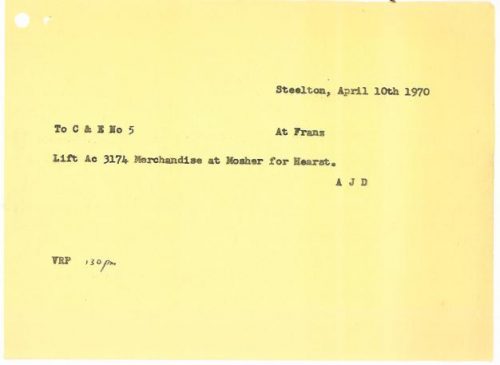This message form addressed to the crew of train No. 5 (Hawk Junction to Hearst freight) on April 10, 1970 instructs the northbound train to lift AC 3174 (a 40′ wooden boxcar) from the Newaygo Forest Products camp at Mosher to bring to Hearst.
Mosher was a sizeable logging camp operated by Newaygo Forest Products but very remote, with no road access other than rough logging roads so many supplies were brought in and out by rail via the Algoma Central Express department.
The below 1973 photo courtesy of Ted Ellis shows the main common buildings at Newaygo’s Mosher operation with a similar 40′ wood boxcar again spotted near the main buildings. Loaded pulpwood gondolas fill up the rest of the shed track. Partially visible in the background behind the buildings are the actual “Mosher South” loading spurs.



I heard that there were some school cars that would move from place to place, have kids in for lessons for a few days then move on to another place. Do you have any info on that?
I’ve never heard whether the ACR specifically had one, but I know CN had several travelling school cars, and there are a couple preserved in Clinton and Capreol.
I’ve never heard or read of such a car on the ACR, that I remember; certainly, not on the equipment registers I’ve seen – though it wouldn’t have been a revenue car, so registers wouldn’t likely list it anyway. Given the ACR’s propensity for recycling old passenger cars into all sorts of equipment, if they had needed such a car I think it would have existed.
Dale Wilson might have a better idea – not sure if he is watching this ACR blog, though, so you might need message him directly, or reach out via the email group.
This reply from Dale Wilson:
“Apparently not. I do know that Franz and Hawk had schools for some years, and likely the same would have been the case for Oba and Hearst. A number of sons and daughters of ACR employees (like section foremen) attended school in the Sault. I personally knew several. Also, in the mid 1920s when school cars were introduced on both CP and CN, the [then] Department of Education began correspondence courses which would allow a student to at least finish their elementary level education.”